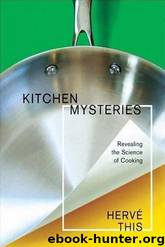Kitchen Mysteries by Hervé This

Author:Hervé This
Language: eng
Format: mobi, epub
Publisher: Columbia University Press
Published: 2010-11-25T18:30:00+00:00
Sauces
CREAMY, SATINY, FLAVORFUL
Neither a Juice nor a Purée
Before they sang of Trojan heroes or the adventures of Ulysses, the Greek poets invoked the Muses, who were supposed to ensure the truth of their poetic madness. As modern bard of one of the basic components of cooking—the sauces—I invoke Ali-Bab, that early-twentieth-century French engineer who, upon returning from his numerous world travels, offered gourmands the fruits of his long travel experience. His Gastronomie pratique hardly merits its name, but his paragraph on sauces deserves to be quoted:
Sauces are liquid food combinations, thickened or unthickened, that serve to accompany certain dishes.
Thickened sauces, by far the most important, all consist of a more or less succulent stock, seasoned, and a thickening agent. The number of stocks for sauces is considerable, the number of aromatics very great, and there are many ways to thicken a sauce. Thus, given these circumstances, it is easy to understand that, with the number of possible combinations being infinite so to speak, here lies a veritable gold mine for the treasure seeker.
What does this quotation teach us? That sauces are thickened to various degrees, but that, generally, a sauce is neither a juice nor a purée. With their highly sophisticated consistency, sometimes syrupy, sometimes creamy, always flavorful, sauces must have a certain quality to accompany fish, meat, vegetables, and desserts.
This precept is implicit in Ali-Bab’s description. For sauces, the key words are “consistency” and “flavor.” If you examine various recipes for sauces that you have already made, you will see that these two basic elements are present every time: a flavorful liquid and a thickening agent.
If the question of flavor has come up in other chapters, the question of consistency, absolutely crucial, has hardly been mentioned until now. Two recent scientific findings, obtained by researchers in Dijon and Nantes respectively, will convince us of its importance.
First, in Dijon, Patrick Etiévant, a physical chemist at INRA, offered tasting panels various strawberry jams in which differing amounts of jelling agents had been added in order to obtain varying degrees of firmness. The same batch of fruit had been used in all of them, and each of the test jams was analyzed for its chemical composition. Verdict: the firmer the jams were, the less flavor they had.
Second, at the INRA station in Nantes, Michel Laroche and René Goutefongea studied liver mousses in which, to make them lighter, they replaced part of the fat with a hydrocolloid, that is, essentially, a starch of water and flour. Once again assisted by taste testers, these two Nantes researchers discovered that the flavor quality of the liver mousses prepared in this way depended on the consistency. The more hydrocolloids the mousses contained, the more they melted in the mouth ... and the better tasting they were.
Thus not only do we expect a particular consistency from a particular dish, but the perception of flavors and scents depends on that consistency.
Download
This site does not store any files on its server. We only index and link to content provided by other sites. Please contact the content providers to delete copyright contents if any and email us, we'll remove relevant links or contents immediately.
Whiskies Galore by Ian Buxton(41544)
Introduction to Aircraft Design (Cambridge Aerospace Series) by John P. Fielding(32897)
Rewire Your Anxious Brain by Catherine M. Pittman(18331)
Craft Beer for the Homebrewer by Michael Agnew(17940)
Cat's cradle by Kurt Vonnegut(14785)
Sapiens: A Brief History of Humankind by Yuval Noah Harari(14002)
Leonardo da Vinci by Walter Isaacson(12821)
The Tidewater Tales by John Barth(12406)
Underground: A Human History of the Worlds Beneath Our Feet by Will Hunt(11850)
Thinking, Fast and Slow by Kahneman Daniel(11816)
The Radium Girls by Kate Moore(11642)
The Art of Thinking Clearly by Rolf Dobelli(9942)
A Journey Through Charms and Defence Against the Dark Arts (Harry Potter: A Journey Throughâ¦) by Pottermore Publishing(9143)
Mindhunter: Inside the FBI's Elite Serial Crime Unit by John E. Douglas & Mark Olshaker(8727)
Tools of Titans by Timothy Ferriss(7833)
Wonder by R. J. Palacio(7750)
Turbulence by E. J. Noyes(7720)
Change Your Questions, Change Your Life by Marilee Adams(7394)
Nudge - Improving Decisions about Health, Wealth, and Happiness by Thaler Sunstein(7264)
